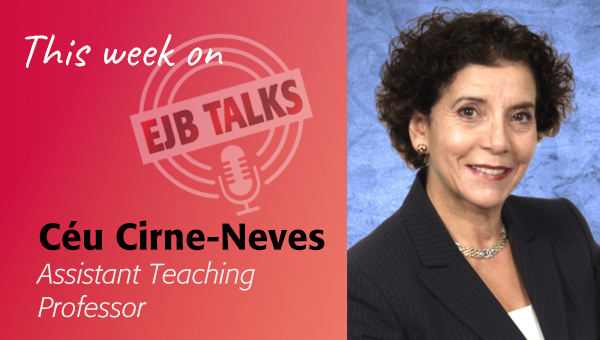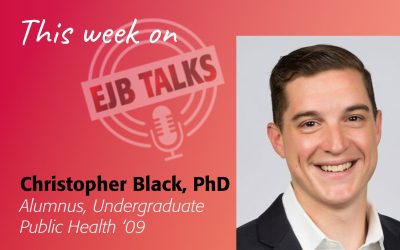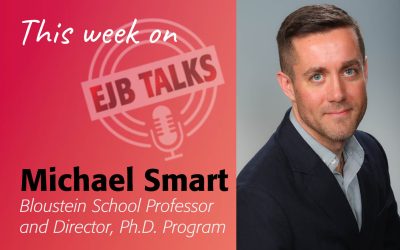This week on EJB Talks Dean Stuart Shapiro welcomes Professor Ceu Cirne-Neves, who teaches in the Bloustein School’s health administration program. Ceu talks about her journey from journalism to healthcare administration, her extensive career in hospital administration, and the significant changes in the healthcare industry that she has experienced over the years. Emphasizing the impact of patient safety, the high-reliability movement, and the value-based reimbursement model on healthcare management, she also touches upon the effects of hospital mergers on patient care. They discuss the attractiveness of health administration as a major for students while highlighting the diversity and generosity of students at the Bloustein School. Ceu ends the discussion with an explanation of her teaching goals, which include developing competency, fostering leadership, and instilling a lifelong learning mindset in her students.
Full transcript:
Stuart Shapiro
Welcome to EJB Talks. I’m Stuart Shapiro, the dean of the Bloustein School. And the purpose of this podcast, now in its ninth season, is to highlight the work my colleagues and our alumni in the fields of policy, planning and health are doing to make the world a better place.
This season our ninth, we are starting by speaking with some of our new faculty that we didn’t speak with this past spring. Today, I’m speaking with Professor Ceu Cirne-Neves, who last year started teaching in our Health Administration program. The MHA, which is less than a decade old, recently debuted at a very impressive 32nd in the national rankings and Ceu is, of course, part of the reason for its success. Ceu, welcome to the podcast.
Ceu Cirne-Neves
Hello, Stuart, thank you so much for the invitation.
Stuart Shapiro
We’re glad to have you here! So let’s get started with learning a little bit about you. Why did you become interested in healthcare? How did you get into that as a career?
Ceu Cirne-Neves
Oh, that’s a nice question. So I grew up in Newark, in the Ironbound section. That’s a multilingual, multi-ethnic neighborhood where I felt very much at home. I graduated from Rutgers-Newark with a degree in English and journalism and had my goal to move out and be a newspaper reporter. So I got my first job in Roxbury with the Times Leader. But soon, two years later, I returned back to the Ironbound. I came back home, where I obtained a job with the Luso Americano News Weekly.
So this news weekly covered the community, and this is when I became acutely aware of the community’s struggle to access health care. This was partly because of the lack of health insurance, the language barrier, and other cultural concerns. The local hospital, St. James, had a brand new CEO, and this new CEO wanted to make changes. So he then invited me and I was hired to head up the hospital’s Department of Volunteer Services and PR. However, I could tell that community outreach was probably the number one priority for the hospital. So soon, I was invited to be at the decision-making table, where we worked on improving clinic evening hours, improving emergency room wait times, and adding financial counseling–more robust–all to help the community better access health care.
Later, I moved on to another hospital. In that other hospital had the opportunity to be involved and learn about strategic planning, operations, and reengineering, and then I was recruited back to St. James. So it’s like, you could take the girl out of the Ironbound cannot take the Ironbound out of the girl. (laughing) This time, however, how was recruited to be the CEO. It was quite a dramatic change from my career. But the community, the advisory board, the board of the system at the at the time, felt that I was going to make a change and a difference and I did.
So my stint as CEO at St. James lasted 10 years. And during that time, we made great strides in adding services such as the level two nursery, modernizing the emergency department, and adding a much-needed mental health unit. From there, eventually, I moved on to Livingston, my last full-time health administrative job prior to joining the faculty. And this was with RWJBarnabas Health in Livingston. I had the pleasure of being the chair of the Leadership Development Institute and developing and nurturing a brand-new operating leadership model for the organization. I was also invited to be the strategic planning process owner and I served as the VP of Ambulatory Services. So these were like, a variety of rich experiences that progressed. At the same time that I obtained my master’s degree, I obtained certifications in LEAN, a certified professional in healthcare administration and management, a professional in healthcare quality, and a senior examiner for the National Baldrige Performance Excellence Program. I got involved with the American College of Healthcare Executives chapter and eventually became chapter president. And as a matter of fact, this year, I have been elected to serve as ACHE Regent for New Jersey.
Stuart Shapiro
That’s quite a career there, that’s quite a run! I had no idea you started as a reporter.
Ceu Cirne-Neves
It’s very interesting as the world turns how we land ourselves in the right job in a roundabout way.
Stuart Shapiro
It’s amazing how many people I’ve talked to on here. And I include myself in this. Who started out doing something completely different than what they ended up doing. We really do travel circuitous paths to where we end up there.
Ceu Cirne-Neves
But it seems like my theme was that I was not only taking care of my career advancement and leadership development, but I also had mentors and sponsors along the way.
Stuart Shapiro
And that is really important.
Ceu Cirne-Neves
I want to do a shout-out to my, my first mentor, Daniel Marcantuno. It made a tremendous difference.
Stuart Shapiro
And was that at St. James?
Ceu Cirne-Neves
So he was the person at St. James Hospital who hired me originally as director of volunteers, public relations, and fundraising, and eventually moved on. And I still had a relationship with him. And he continued to influence my career development.
Stuart Shapiro
That’s great. So you were involved with hospitals for a long time, and you’re obviously still very plugged into that world. What’s the biggest change that you saw over the course of your career?
Ceu Cirne-Neves
I would say that there were two seminal events that accelerated change in healthcare management to the version that we have today. And of course, it’s still progressing. But it was the patient safety and high-reliability movement, with a goal to zero preventable harm. A, and also b, the value-based reimbursement model where hospitals are currently financially at risk for poor quality. And these two movements started with the publication of the “err is human” in 1999, by the US Institute of Medicine…
Stuart Shapiro
I was in I was at the federal government at the time, and it made a big splash.
Ceu Cirne-Neves
Shocking! It just said that at least 98,000 people die in hospitals annually due to preventable causes. And we all understand it’s way understated. The second seminal event was the adoption of the Accountable Care Act (ACH) of 2010, which brought about so many changes. For example, the electronic health records and the patient portals. Because then hospitals receive subsidies. And they encourage physician practices to also adopt electronic medical records and health records. And then, in addition, the patient satisfaction survey, which we call HCAHPS [H-CAPS] became one of the metrics in the quality dashboard.
Who would have thought that we would be including the patient’s opinion in our quality dashboards? The requirement that hospitals conduct collaborative community health needs assessments and improvement plans. That’s novel as well. And that’s an IRS requirement today, that every three years hospitals have to do this. That was amazing what it did to us in terms of hospital administration. And then last but not least, the fact that the hospitals are now at-risk contracting with commercial insurers, which has led to the creation of what we are calling the Office of Population Health and the Office of Transformation. What that is, is really understanding that we have to move from volume to value. And we have to create processes and databases and action plans to improve how the prevention component of patient care and to prevent the patient from going to the emergency department, encouraging screenings, and all of that is listed as part of that risk management.
Stuart Shapiro
Those are big changes indeed. Now, speaking to you — as a former hospital CEO — you’ve talked about all of these requirements that have been coming into place and all of this increased emphasis on the patient. How do you balance that with needing to stay open and being financially viable?
Ceu Cirne-Neves
I think what happened was hospitals began merging. Because hospitals, they were standalone, or even small hospitals that were part of a system could no longer afford to put in place all that is required. Patients, physicians, nursing staff, they demand the very best. They demand state-of-the-art. If you cannot afford to have a state-of-the-art facility, like single rooms, which is now the norm. Like the best technology in DD. To have a CAT scan in the ED is a novel idea.
Stuart Shapiro
What’s in the ED?
Ceu Cirne-Neves
So a CAT scan in the emergency department so that the patient can be ruled out and the decision is made to admit or not, quicker than to have the patient have to be traveling to the inpatient radiology department or have this CAT scan done. So all of this new additional technology and some redundancy is not for every hospital. And of course, the cost of medications, meds. And of course supply chain. And of course, the workforce — the cost of nursing today versus the cost of nursing back then. So labor, supply chain, technology, medications, and then also the quality indicators that we need to pursue. That has made hospitals merge, to close, to figure out ways — at most, we used to have something like 90 acute care hospitals in New Jersey, we now have 70. Seven-zero. We now have dominant, humongous healthcare systems, and a few only-standalone medical centers. Because in order to be able to off-balance that patient care and patient innovation and cost with reimbursement.
Stuart Shapiro
That’s fascinating. How do you think all of these mergers have affected the patient experience?
Ceu Cirne-Neves
From my experience it’s been very positive, because these organizations are large enough to put resources in place to actually make changes that improve the communication with the doctor, communication with nurse, education at discharge, making sure that the patient is well cared for even as they are being discharged. Gone are the days where you just get a signature and you put the patient in the family’s care and the patient goes home. Now we need to make sure there’s home care assigned to that patient. All this requires resources. But the fact that hospitals have merged, have also brought those resources together to serve. Some may consider lack of competition a concern. But competition in healthcare is not always positive. Duplication of services and duplication of technology is costly. And this brings our healthcare system in the United States being at $12,000 per capita, when the average for industrialized countries being at half, $6,003.
Stuart Shapiro
That’s amazing.
Ceu Cirne-Neves
So competition in healthcare is not always positive. Although it can be argued that taking away competition can also be a concern.
Stuart Shapiro
Right, right. Yeah, that’s a fascinating topic. And we could get into that a lot more. I do want to hear a little bit about your teaching experience since you got here. Why do you think health administration has become such an attractive major for students and particularly our students?
Ceu Cirne-Neves
Right, I would like to answer the question with the salary. And the salary is a very large part. Not only the salary that you first obtain, which might be up to par with the competition and the norm, but the opportunity and the potential to be promoted within the system. And to actually get to the next level is more likely to happen in a healthcare organization. And this is because hospitals have a vast array of professional experiences to offer. An early careerist may be working in performance improvement, population health, growth strategies, quality and safety. And then they may be promoted to head up the service line. To be part of a physician dyad where you’re actually bringing quality and volume to that hospital. And then you can eventually move on to be in charge of a bunch of departments as an assistant vice president.
So this is an opportunity to get to the C-suite. One of the students in our master’s program today can get, and be, in the C-suite level tomorrow. The second is because I believe that health administration is mission, vision, and values-driven. And there are still a lot of us who really take a lot of comfort in understanding that what we do impacts the lives of those we serve very directly. So I believe it’s all of the above.
Stuart Shapiro
Well, that’s, you know, comfort to this Dean’s ears in that, we obviously want to provide our students with a lucrative career if possible, but we also want them to stay centered in serving the public and in improving public welfare. Which certainly our hospital administrators play a role in doing. What do you want your students to get out of classes?
Ceu Cirne-Neves
And most of all, I want my students to achieve the competency levels that we are assisting them with, because those are the competency levels required to be competitive in the job market and to be successful in your job. We want them to develop their own leadership model. They hear a lot about theories, and they hear a lot about best practices. But at the end of the day, it’s their personal commitment to how they want to behave in the workplace. I want them to be the change. And that leadership model would allow them, then, to forge their own path within the within the constraints of the health administration opportunity. And to learn, to translate the organization’s mission, vision, and values into goals, work plans, key metrics and results.
These opportunities, these jobs in health administration, at the end of the day have to be results-driven. And that’s because quality is not a nebulous word. Quality has metrics. It’s about timeliness. It’s about effectiveness. It’s about turnaround time, it’s about being patient-centered. So I really want my students to understand what the results of their labor need to be. And also I want my students to understand from the start that they need to adopt a lifelong learning mindset. They have to be the ones seeking out opportunities, and take advantage of what we are offering them and then go into the field and make a difference in their organization by keeping up their learning and keeping up that opportunity for professional development.
Stuart Shapiro
That’s great. And let me let me end by saying, you know, you’ve come from being an executive of the hospital. You’ve been teaching with us for a little while now. What surprised you about coming into the classroom?
Ceu Cirne-Neves
I’m surprised by the diversity, because in general, we talk about the need for diversity. Well, at Bloustein, we have diversity. The classrooms are now both undergraduate health administration, in which I teach population health, and the master’s level where I teach the MHA practicum. These students are going to change the face of healthcare in New Jersey or healthcare administration in New Jersey. I’m also very amazed at how much they give back, that these students might be first-generation students. They might have a job, they may have a family, and yet they find ways to contribute. So the MHA program is working on an October conference, co-sponsored with ACHENJ. And the undergraduate program, the future healthcare administrators are working on a career day for November and a case competition for April. So these students are very generous with their time and their contribution to the profession and the community.
Stuart Shapiro
Well, they have a good role model for that in you. Thank you. Thank you so much for coming on today Ceu.
Ceu Cirne-Neves
Thank you.
Stuart Shapiro
A big thank you as well to our producer Tamara Swedberg and to Karyn Olsen for the work she does behind the scenes. We’ll see you next week with another talk from another expert at the Bloustein School. Until then, stay safe!




